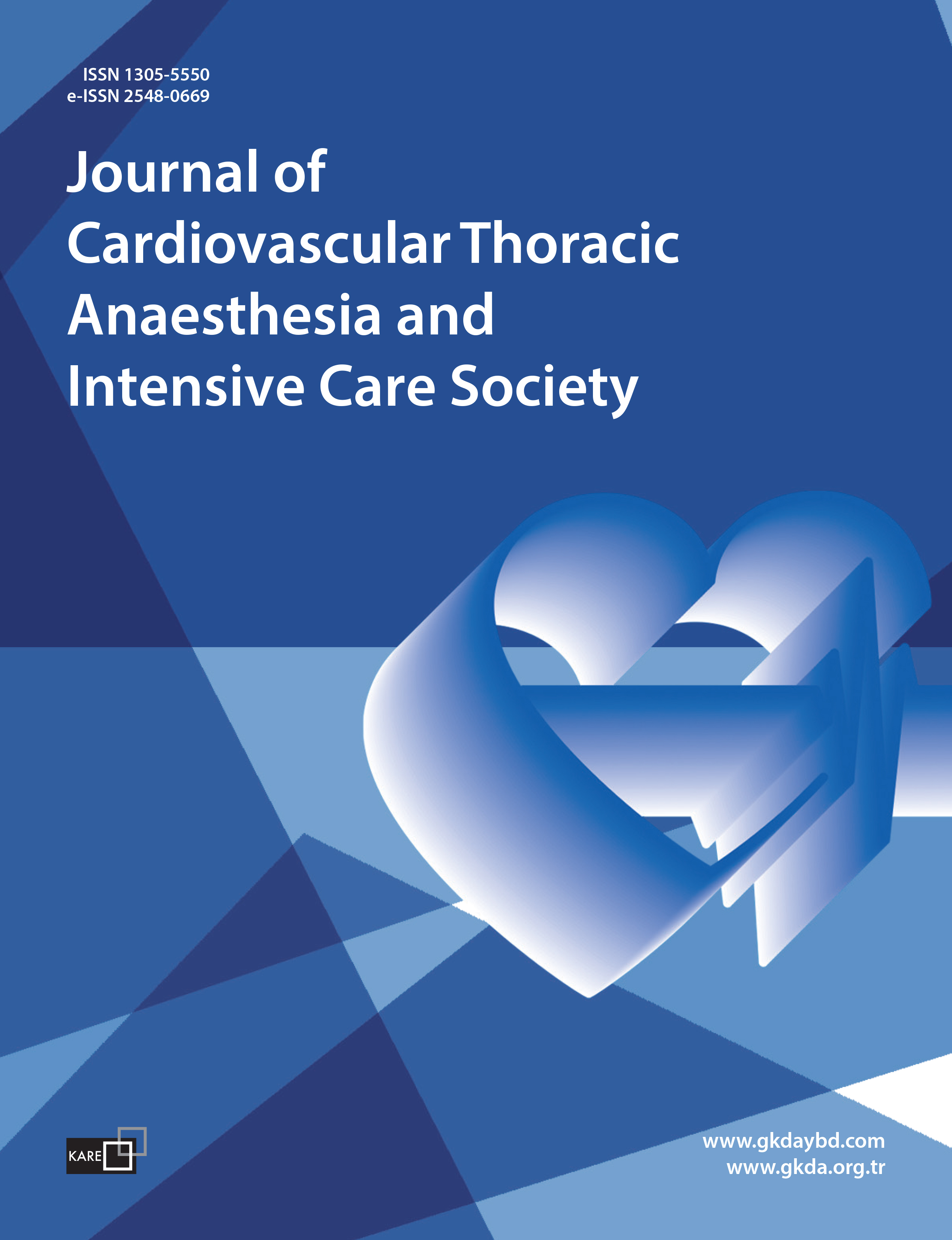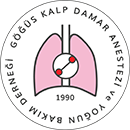

Volume: 27 Issue: 2 - 2021
| 1. | Cover Page I (440 accesses) |
| 2. | Editorial Consultants Pages II - III (600 accesses) |
| 3. | Contents Pages IV - V (382 accesses) |
| 4. | Publication Policies and Writing Guide Pages VI - XII (412 accesses) |
| REVIEW | |
| 5. | Anesthesia for Liver Transplantation Zeynep Ersoy, Nedim Çekmen, Adnan Torgay doi: 10.5222/GKDAD.2021.57614 Pages 111 - 130 (4697 accesses) Orthotopic liver transplantation (OLT) is the gold standard treatment for patients with end-stage liver disease. Understanding of the multisystem physiology of end stage liver desease (ESLD) is fundamental to the management of transplant recipient. Since OLT is a very dynamic process, a multidisciplinary approach and optimization is essential in the perioperative period. During the management anesthesiologists should focus on significant hemodynamic instability, physiology, metabolic disturbance and coagulopathy of those patients. The aim of this review was to summarize peroperative and anesthesia management in line with the guidelines. |
| RESEARCH ARTICLE | |
| 6. | Association of American Society of Anesthesiology and Modified Charlson Comorbidty Index Scores with Survival in Geriatric Patients Undergoing Thoracic Surgery Fatih Doğu Geyik, Yucel Yuce, Banu Cevik, Kemal Saracoglu doi: 10.14744/GKDAD.2021.21033 Pages 131 - 138 (623 accesses) Objective: We aimed to evaluate the relationship between preoperative American Society of Anesthesiology and Modified Charlson Comorbidty Index scores and postoperative survival in geriatric patients who had undergone thoracic surgery. Methods: A total of 109 patients aged 65 years and above who had undergone thoracic surgery under elective conditions were included in this retrospective study. Results: Patients who died within the first postoperative two years had higher American Society of Anesthesiology IIIIV scores (p=0.03), higher Modified Charlson Comorbidty Index scores (p=0.04), and lower hemoglobin and hematocrit values (p=0.02 and p=0.005, respectively). We found that Modified Charlson Comorbidty Index was significantly effective in predicting two-year mortality among geriatric patients (AUC = 0.648, 95% CI: 0.5160.780, p=0.02). In the ROC analysis, the best predictive cut-off value for Modified Charlson Comorbidty Index was found to be 7 (sensitivity: 79.7%, and specificity: 44.4%). Conclusion: The cautious choice of patients for the medical procedure has contributed to the improvement in mortality rates after some time, and with refinements in preoperative testing meticulous patient selection should be maintained. |
| 7. | Management of Anesthesia and Complications in Pulmonary Endarterectomy Operations Atakan Erkılınç, Pınar Karaca Baysal doi: 10.5222/GKDAD.2021.43760 Pages 139 - 146 (1262 accesses) Objective: Chronic thromboembolic pulmonary hypertension is a chronic progressive disease developing obstruction ocurring in pulmonary vascular bed. Pulmonary endarterectomy is the surgical procedure described in the management of chronic pulmonary hypertension which excises, and removes the obstructing thromboembolic material from the affected vascular structures. Our aim is to share our approaches to the management of anesthesia and complications in pulomanry endarterectomy operations performed in our center. Methods: The data of 200 PEA cases conducted in June 2017-2020 were retrospectively analyzed. The demographic data of the patients, preoperative pulmonary function tests, cardiac catheterization findings, peroperative cardiac output measurement values, aortic cross clamp, extubation, intensive care unit, and hospital stay times and complications were recorded. Results: Average age of the patients ages was 50.8 years, and female/male ratio was 108/92. In the thermodilution measurements of the patients after induction, mean values of CO, PVR and mPAP were determined as 4.4 l/min, 594 dyn/s/cm-5, 40 mmHg, respectively. The corresponding measurements made after the sternal closure were stated as 6 l/min, 241 dyn/s/cm-5 and 28 mmHg, respectively. The patients were hospitalized in the intensive care unit for 4 days. In our patient group residual pulmonary hypertension occurred in 21%, reperfusion pulmonary edema in 10% and pulmonary bleeding in 4% of the cases. Conclusion: Only a very few centers in the world are experienced in PEA surgery. Anesthesia management and treatment of the complications of PEA surgery are quite difficult. Therefore, PEA surgery shl be performed in experienced centers. |
| 8. | Comparison of the Intraoperative Hemodynamic Effects of Remifentanil and Fentanyl in Pediatric Cardiac Surgery Anesthesia Osman Uzundere, Fikret Salik, Cem Kıvılcım Kaçar, Aylin Erkul, Mustafa Bıçak, Onur Doyurgan, Fatih Özdemir doi: 10.5222/GKDAD.2021.42650 Pages 147 - 154 (1520 accesses) Objective: The aim of this prospective observational study was to compare the hemodynamic effects of remifentanil and fentanyl, which are used as intraoperative analgesics in pediatric cardiac surgery. Methods: Patients were divided into two groups as those who received continuous intravenous remifentanil infusion (Group R) or intermittent intravenous fentanyl for intraoperative analgesia (Group F). These groups were compared in terms of hemodynamic characteristics and intraoperative complications. Results: The most common congenital cardiac pathology observed in the patients included in the study was ventricular septal defects (32%). Intraoperative complications occurred in 21 (40%) patients, and ventricular fibrillation was the most common complication (n=6; 11.5%). When the patients in both groups were compared in terms of intraoperative hemodynamic indicators, the mean arterial pressure values of the patients in Group R after sternotomy were significantly lower than those of the patients in Group F (p=0.034). No statistically significant difference was found between the two groups in terms of other hemodynamic indicators. When the two groups were compared in terms of intraoperative complications, the difference was not statistically significant although the number of patients with complications was higher in Group F (p=0.1). Conclusion: As a result of this study, it was found that remifentanil was as effective as fentanyl in maintaining intraoperative hemodynamic stability in patients undergoing pediatric cardiac surgery. |
| 9. | Comparison of Mid-, and Late- Term Morbidity and Mortality Results of Surgical Endarterectomy Versus Endovascular Stent Implantation in Carotid Artery Stenosis Ismail Selcuk, Nehir Selcuk, Murat Fatih Can, Ahmet Turan Yılmaz doi: 10.5222/GKDAD.2021.63496 Pages 155 - 160 (1866 accesses) Objective: Carotid artery stenosis is an important etiological cause of cerebrovascular events and stent implantation is widely used as an alternative treatment to endarterectomy. In this study, we compared the mid and late-term results of carotid artery stenosis patients who underwent endarterectomy and stent implantation. Methods: Patients who underwent endarterectomy (Group A, n: 27) and endovascular stent implantation (Group B, n: 22) due to carotid artery stenosis between 2008 and 2014 were included in the study. All examination, laboratory data and radiological images were collected from the hospital database. Morbidity and mortality developed in the mid (1-12 months) and late term (>12 months) periods were evaluated retrospectively. Results: While there were no neurological complications and restenosis in the midterm in Group A, 2 patients (9.09%) had stroke and 2 patients (9.09%) had restenosis in Group B. In the late-term, while there were no neurological complications in Group A, stroke in 3 patients (13.63%) (p=0.048) in Group B, restenosis was observed in 1 patient in Group A and 5 patients in Group B (3.7% vs 22.72%, p=0.043). Conclusion: We recommend endarterectomy as the primary approach for carotid artery revascularization and percutaneous approach especially in high-risk patients with recurrent ICA stenosis and distal carotid artery lesions.ry lesions. |
| 10. | Comparison of Postoperative Analgesia Efficacy of Preemptive Intravenous Ibuprofen and Paracetamol in Endovenous Laser Ablation under General Anesthesia Onat Bermede, Volkan Baytaş doi: 10.5222/GKDAD.2021.82712 Pages 161 - 165 (602 accesses) Objectives: The aim of this study is to compare the effects of preemptive intravenous ibuprofen and paracetamol on acute pain scores, opioid consumption and patient satisfaction in patients who will undergo endovascular laser ablation under general anesthesia. Methods: After induction, 1 g Paracetamol for Group P or 800 mg Ibuprofen for Group I was administered as a slow infusion by a separate intravenous route. Both drugs were followed by a repeat dose every 6 h until discharge. Visual analogue scale (VAS) was used for pain intensity at PACU and after the first, second, sixth hour after surgery. In case of acute pain (VAS ≥ 40) 1 mg intravenous morphine was used as a rescue drug. VAS scores, length of stay, total opioid consumption and patient satisfaction status was evaluated before discharge. Results: A total of 82 patients (42 in Group P and 40 in Group I) were included. There was no difference between the VAS scores. Total morphine consumption was 0.33 ± 0.47 in Group P, and 0.30 ± 0.43 in Group I (p = 0.42). Hospital length of stay was 6.4 ± 1.7 hours in Group P and 6.2 ± 1.4 hours in Group I (p = 0.51). Patient satisfaction status evaluated at discharge was found to be similar. Conclusion: There is no difference between preemptive intravenous paracetamol and ibuprofen in patients undergoing EVLA under general anesthesia in terms of postoperative acute pain scores and opioid consumption. Both drugs can be safely applied in this type of surgery. |
| 11. | Age-related Hemodynamic Effects of Long-term Use of Dexmedetomidine During NIV. Lerzan Dogan, Duygu Emine Guduk, Ilkay Kisa Ozdemir, Tugce Sarikaya doi: 10.5222/GKDAD.2021.69370 Pages 166 - 170 (614 accesses) Objective: Sedation in the intensive care unit plays a key role in patient management as it helps suppress agitation, increases tolerance to stress, and facilitates medical interventions, such as noninvasive ventilation (NIV) Our purpose was to determine the long-term hemodynamic effects of dexmedetomidine in elderly patients with acute respiratory failure who require NIV. Methods: We recorded the data concerning age, comorbidities, doses of dexmedetomidine, hemodynamic parameters, use of vasopressors and length of ICU stay, from the hospital electronic medical recor system Due to the possibility of causing hemodynamic instability in ICU, patients with reduced ventricular contractility, hypothermia, septic shock, endocrine pathologies and neurosurgery cases, were excluded from the study. Results: The patients were evaluated in four age groups: Group I: 18-39 years; Group II, 40-64 years; Group III, 65-80 years, and Group IV, aged >80 years The patients in group IV were found to be at a higher risk for a decrease in MAP following onset of dexmedetomidine treatment (p=0.005*). Notably, most of the vasoactive agents were used in patients over 85 years old (54.2%, p=0.005). With increasing age hypotension and vasopressor needs were found to exhibit a corresponding augmentation. Conclusion: Dexmedetomidine meets requirements for sedation during NIV in the ICU. Even without loading dose the drug can induce hemodynamic instability, therefore close monitoring is necessary. In elderly, dexmedetomidine should be started at the lowest possible dose and slowly titrated according to the patients response. |
| 12. | Effects of Differences in Doses of Low-Molecular Weight Heparin in Severe COVID-19 Patients Mine Altınkaya Çavuş, Hafize Sav doi: 10.5222/GKDAD.2021.48343 Pages 171 - 174 (1377 accesses) Objective: The most prominent clinical finding in severe COVID-19 patients is endothelial damage. For these reasons, active administration of anticoagulants (such as heparin) is recommended to patients with severe COVID-19. The purpose of this study is to investigate the effects of different doses of low-molecular weight heparin (LMWH) on severe COVID-19 patients. Methods: This study was performed retrospectively in intensive care unit of a tertiary referral hospital. PCR (polymerase chain reaction) positive (+) patients were included in the study. Patients demographic data, length of stay in the hospital and intensive care unit, laboratory values (D-dimer, CRP, creatinine) on the last day of intensive care stay, mortality and invasive mechanical ventilator needs were recorded. Group O: consisted of patients not receiving anticoagulants, and Group 1 received a single daily dose of 40 mg enoxaparin sodium (equivalent to 4000 anti-Xa IU), and Group 2 received 2 daily doses of 1 mg/kg enoxaparin sodium. Results: A total of 191 patients were included in the study. 45% of the patients were female (n: 86), 55% were male. The mean age was found to be 67.6 ± 13.8. Patient numbers; group 0: 12, group 1: 90, group 2: 89. 7-day mortality was 50% in group 0, 22.2% in group 2, and 23.5% in group 3 (p value <0.05). Conclusion: In a recent lung dissection report in critically ill patient with COVID-19; occlusion of pulmonary small vessels and formation of microthrombosis have been demonstrated. Prophylactic doses of LMWH are used more frequently. Some studies have suggested that septic patients may benefit from early diagnosis and specific treatment. As a result; in severe COVID-19 patients with limited mobilization, all doses of LMWH reduce morbidity and mortality. |
| LETTER TO THE EDITOR | |
| 13. | Is Stroke The Main Determinant Of The Intensive Care Stay Duration In Coronary Artery Surgery? Seher İrem Kıran, Fevzi Toraman doi: 10.5222/GKDAD.2021.03780 Pages 175 - 176 (555 accesses) Abstract | |
| CASE REPORT | |
| 14. | Why My Patient's Urine Was Green in Intensive Care Unit ? Ezgi Balıkoğlu, Ahmet Arıkanoğlu, Ahmet Salih Tüzen, Elif Gözde Doktaş, Senem Girgin, Nagihan Karahan, Murat Aksun doi: 10.5222/GKDAD.2021.66933 Pages 177 - 179 (648 accesses) Introduction: Urine analysis is an important part of patient follow-up in intensive care unit (ICU). In this case report we aimed to examine the green colored urine image we see in our ICU and the conditions that may cause this. Case: A 70-year-old male patient was admitted to our ICU due to multilobar pneumonia. During the follow-up, he was intubated due to respiratory distress and15 mcg-1kg-1min propofol infusion was started for sedation. It was observed that the urine was green after 16 hours. Factors that could cause color change in urine were evaluated. Infusion was stopped due to similar cases in the literature. The total amount of propofol administered to the patient was 1200 mg. It was observed that the urine color returned to normal 8 hours after the drug was discontinued. Conclusion: A rare side effect of propofol is urine discoloration. Urine color may change when the excretion of phenolic metabolites exceeds hepatic clearance. It is reported that it can be seen even in anesthesia induction or sedation doses. It is important to know that the application of propofol may change the color of the urine, that this will not be an important problem and that the color may return to normal with the discontinuation of the drug, in order to prevent unnecessary tests. |
| 15. | Approach To A Difficult Intubation Case Caused by Tracheal Occlusive Secretions in ICU Hatice Dilek Özcanoğlu, Başol Bay doi: 10.5222/GKDAD.2021.22590 Pages 180 - 182 (1322 accesses) Difficult airway, in other means having problems during tracheal intubation, is quite comman in daily practice. When a unknown or unexpected difficult airway is faced, rapid intervention and appropriate management of the situation is life-saving. In this case report a patient who needed re-intubation due to respiratory distress caused by dry secretions in trachea during ICU follow-up after cardiac valve surgery. The process of unexpected difficulty in re-intubation was managed effectively by rapid and appropriate approach. |

















